This document has been composed to provide a industry reference for radio frequency connectors. The table below has been compiled against applicable ISO/IEC/MIL standards, with the generous assistance from industry leading manufacturers who have been listed below. While comprehensive, this list is not to be considered exhaustive and does not include manufacturer-specific designs.
Gender Designation
RF connector genders are designated either Male (Plug) or Female (Jack) based on the physical characteristics of the connector body and centre contact. IEEE Std 315-1975 provides limited insight stating only that the female/receptacle/jack is usually stationary, and the male/plug is usually movable. IEC 61169 suggests gender is designated on the basis of whether the centre contact consists of a pin or socket. In the absence of any restrictive standard, the accepted practice is to designate on the basis of the following:
- Male or Plug Connector: Centre contact consists of a pin. Body typically features the active part of the coupling mechanism (e.g. coupling nut).
- Female or Jack Connector: Centre contact consists of a receptacle/socket. Body features a coupling mechanism complementary to the plug.
- Genderless Connector: Coupling mechanism does not utilise standard pin-socket contacts. Connector has both male and female (hermaphrodic) elements or surfaces.
Certain connector series, such as SMB, complicate the above ruling whereby the Male connector (i.e., connector with the pin) has a Jack body (i.e., body has no active coupling mechanism), and Female (i.e., connector with the socket) has a Plug body featuring the active coupling mechanism.
Reverse Polarisation
Several connector series also offer a reverse-polarised sub-series in which the connector gender is reversed by swapping the pin and receptacle into the opposing gender's body. For example, a Reverse Polarity Male connector will consist of the Male body with a female socket/receptacle. Reverse Polarity series are named by conjoining the prefix "RP-" to the connector series name, for example, Reverse Polarity SMA connectors are named RP-SMA.
Browse RF Connector Series
| Series | Description | Max. Freq. | Image |
|---|---|---|---|
1.0 mm (W) |
Specialised scientific grade connector. There are two subtypes of 1.0 mm coaxial connectors in use; Laboratory Precision Connectors (LPC), and General Precision connectors (GPC). Laboratory Precision Connectors and General Precision Connectors differ only by permitted tolerances - clearance, flatness, and pin depth. The interface for both LPC and GPC subtypes is air dielectric with the contact ... Also known as W |
110 GHz | 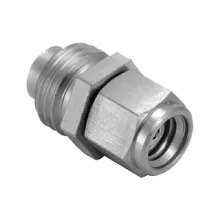
|
1.0/2.3 |
1.0/2.3 series (often called DIN 1.0/2.3) are either a 50 Ω connector with a 10 GHz cutoff, or a 75 Ω connector with a 4 GHz cutoff featuring a smaller centre conductor, both variations are covered by the DIN 47297 standard. 1.0/2.3 RF connectors are characterised by high mechanical and electrical stability. The connectors are designed for high density applications, offering a 40% size reduction to ... Also known as DIN 47297 |
10 GHz | 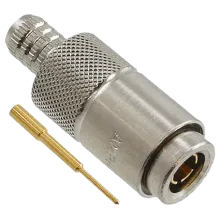
|
1.5-3.5 |
Telegartner's 1.5-3.5 series enables a robust and PIM stable design in the smallest space. The space requirements for a typical 4 hole flange jack are only either 15 × 9.7 mm or 12.7 × 12.7 mm. Therefore the 1.5-3.5, based on the SMA form factor, requires around 47% less space than the 2.2-5 series and 75 % less space than the 4.3-10 series. Hand in hand with the size and material reduction, there ... Also known as |
30 GHz | 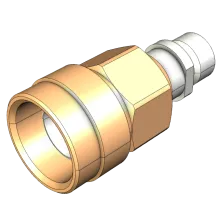
|
1.85 mm (V) |
The 1.85 mm connector is a pin and socket type connector that uses an air dielectric filled interface that assures mode free operation up to 65 GHz. It is also known as the Type V connector. Some manufacturers have demonstrated performance up to 67 GHz. The design has been introduced as an open standard under the IEEE 287 Precision Connector Standards Committee. Also known as V |
65 GHz | 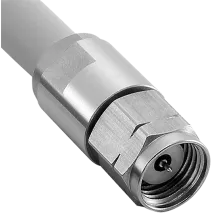
|
2.2-5 |
The 2.2-5 series enables a robust and PIM stable design in the smallest space. The space requirements for a typical 4 hole flange jack are only 17.4 x 17.4 mm. This is the same as the usual mounting surface for the TNC series. Therefore the 2.2-5 requires around 53% less space than the 4.3-10 series and 70% less space than the older 7/16 series. Hand in hand with the size and material reduction ... Also known as |
20 GHz | 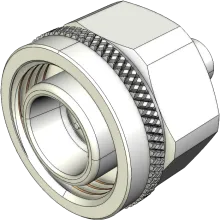
|
2.4 mm (Q) |
The 2.4 mm connector is a pin and socket type connector that uses an air dielectric filled interface that assures mode free operation up to 50 GHz. It is also known as the Type Q, or OS-50 connector. Some manufacturers have demonstrated performance up to 60 GHz. The design has been introduced as an open standard under the IEEE 287 Precision Connector Standards Committee. Also known as Q |
50 GHz | 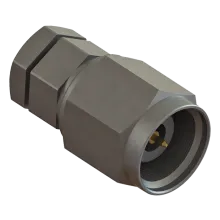
|
2.92 mm (K) |
The 2.92 mm connector is a pin and socket type connector that uses an air dielectric filled interface that assures mode free operation up to 40 GHz. It is also known as the Type K connector. The connector interfaces mechanically with 3.5 mm and SMA connectors, however the junction introduces a discontinuity which must be accounted for. Compared to the 3.5 mm and SMA connectors, the 2.92 mm ... Also known as K |
40 GHz | 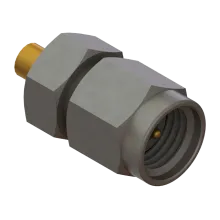
|
3.5 mm |
The 3.5 mm connector is a pin and socket type connector that uses an air dielectric filled interface and closely controlled centre conductor support bead providing mechanical interface tolerances similar to hermaphroditic connectors. With a substantially heavier duty design the connector is capable of handling repeated mating cycles without damage. The connector is also known as APC3.5. This ... Also known as APC3.5 |
35 GHz | 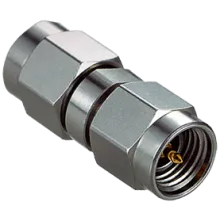
|
4.1/9.5 |
The 4.1/9.5 "Mini-DIN" RF connector has been designed as a compact and low PIM replacement to traditional 7/16 DIN connectors. The 4.1/9.5 connector features a screw on, low torque coupling system, which allows for a secure mate between connectors. As a matter of correctness the 4.1/9.5 connector is often, incorrectly, written as "4.1-9.5". The series can be supplied as IP68 certified from leading ... Also known as 4.1/9.5 Mini-DIN |
14 GHz | 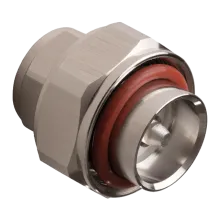
|
4.3-10 |
The 4.3-10 RF connector has been designed as a compact and low PIM replacement to traditional 7/16 DIN connectors, and an iterative improvement over even the more recently developed 4.1/9.5 "Mini-DIN" connector. The 4.3-10 connector features a screw-on, low torque coupling system, with a separation of the electrical from the mechanical plane ensuring performance does not vary with torquing. The ... Also known as |
6 GHz | 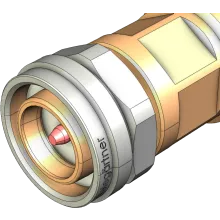
|
7/16 DIN |
The 7/16 DIN connector is a robust, high power handling RF connector with relatively good PIM performance, typically used in broadcast and cellular base station antennas. The name of the connector comes from the nominal values of 16 mm at the interface for the internal diameter of the outer conductor, and 7 mm for the diameter of the centre conductor. The exact ratio is chosen such that it gives a ... Also known as |
8 GHz | 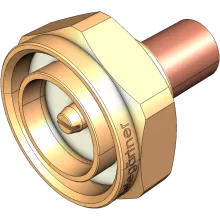
|
BMA |
The Blind-Mate A (BMA) RF connector are a slide-on/push-on series developed for interconnecting microwave modules, using direct mount or floating rear mount. The floating variation of the female connector is employed to provide tolerance against misalignment during mating, and has also made the series popular in high vibration applications. The connector series is commonly referred to as OSP ... Also known as OSP |
22 GHz | 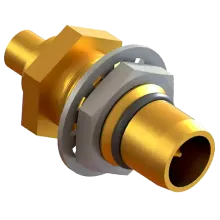
|
BMZ |
The Blind-Mate Z (BMZ) RF connector is a miniaturised version of the slide-on/push-on BZ connector providing operation up to 18 GHz. The female connector can have a floating design to provide tolerance against misalignment during mating. The connector series is commonly referred to as PMMA, despite the official military standard designation of BMZ. The connector design has been standardised ... Also known as PMMA |
18 GHz | 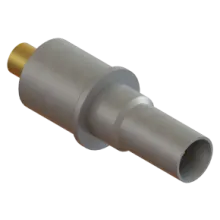
|
BNC |
BNC "Bayonet Neill–Concelman" are a two-stud bayonet-style connector designed for quick mating. BNC connectors are one of the worlds most popular type of RF connector. Originally designed for early military communications, BNC connectors are now commonly used in UHF, radio, electronic equipment, and broadcast up to 4 GHz. Above 4 GHz, BNC slots begin radiating resulting in a hard limit to the ... Also known as Bayonet Neill–Concelman |
4 GHz | 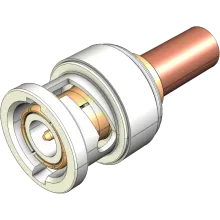
|
CRC9 |
CRC9 is an uncommon RF coaxial connector almost exclusively used in cellular devices such as mobile broadband modems to support connection of an external antenna. The connector passes frequencies up to 3 GHz. Used almost exclusively on Chinese manufactured devices such as Huawei 4G LTE modems, the CRC9 Female connector comprises a very simple circular brass housing with an outer diameter of 3 mm ... Also known as |
3 GHz | 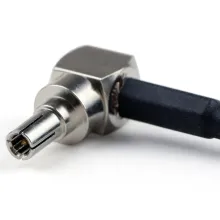
|
Pagination
RF Series by Frequency
The chart below depicts the maximum operating frequency range of RF Connector Series. The maximum value of a series may include precision variations and as such does not apply for all manufacturer variations.